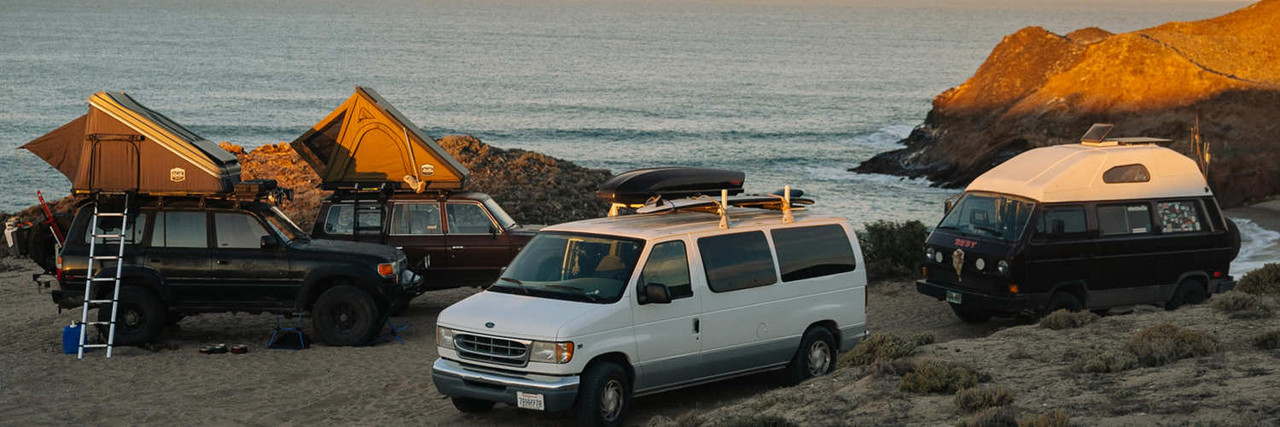What is an Inverter for an RV | a Thorough Guidebook
An RV inverter is able to convert the DC electricity into AC electricity that can be used by cell phones, computers, and other household appliances in your RV. This guide explores how RV inverters work , what best size for RV and will also equip you with the tools tackled any future questions you might have about RV inverters.
What’s an inverter used for in an RV?
If you remember your 5th grade science well, you know there are two kinds of power or electricity, which are:
1.Direct Current (DC)
2.Alternating Current (AC)
Direct Current (DC) is the power that you normally get from batteries and solar panels. On the other hand, Alternating Current (AC) is the type of electricity you get when you plug your TV into a wall outlet.
So what does an inverter do?
Any inverter, including an RV inverter, is a device that converts Direct Current (DC) electricity from a battery or solar panel into Alternating Current (AC) that most modern appliances can use. You can have all the DC power you want but without an inverter, you will not be able to power up any of your AC devices in your RV or home.
There are many kinds of inverters designed for different uses and industries. In your case, if you are looking for something that’s more RV-friendly, look for RV inverters from trustworthy companies like Renogy and others.
Now you know how to answer if someone ever asks you, ‘what does an inverter do in an RV?’
How do RV Inverters work?
RV inverters are a special kind of inverter designed to fit and work in an RV environment.
Some of the features that make them ideal for use in RVs are:
1.The form factor is more suitable for use in RVs that are known for their limited space.
2.They are designed to be secured to resist shocks, slips, and sudden movements that other inverters cannot handle.
RV inverters, like other inverters, work by converting the Direct Current (DC) from your RV’s main battery, added batteries, or solar panels into Alternating Current (AC) that can be used by the electronics in your RV like TVs, laptop chargers, fridges, microwaves, and others.
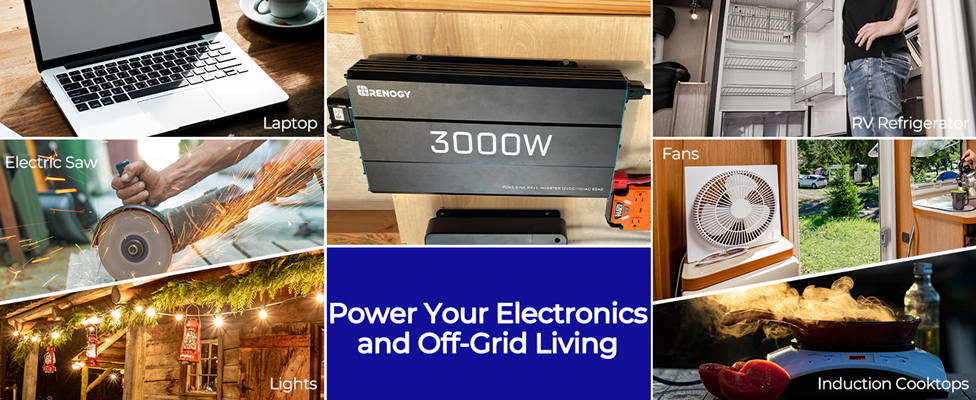
An important fact to know about RV inverters is that the amount of AC power they provide depends on your batteries or solar panel’s capacity. As a result, there’s a limitation regarding:
●The number of devices that can work at the same time
●The devices that require a higher AC output (Stoves, Air Conditioners, Fridges, etc.)
So you have to limit the number and type of devices that can use your inverter’s power output.
To decrease the limit, you can either buy a bigger battery or add more batteries. The same applies to solar panels. The downside to this is that it takes up more space and adds more weight to your RV or motorhome.
How to choose the right inverter size for your RV?
To choose the right RV inverter size, you need to be able to answer these questions:
1.What is the total amount of wattage you need (also accounting for surges in load)?
2.How many devices do you want to run?
3.What type of devices do you want to run?
4.Do you have storage space for your inverter?
5.What is the capacity and type of your batteries or alternative DC power source?
6.Which device draws the most power?
Here is a step-by-step process you can follow to decide on the inverter of the right size for your RV:
● Step 1: List out all the wattage and surge requirements of all the electronics in your RV that you want to power with the inverter
● Step 2: Sum up the running and surge wattage each device requires to come up with a total.
●Step 3: Take this total and multiply it by 1.2 to add an extra 20% capacity that will offset any changes in the system.
●Step 4: Once you know the wattage, you need to choose between a modified sine wave inverter and a pure sine wave inverter. Some devices like microwaves, TVs, and radios don't work well with a modified sine wave inverter. In that case, we recommend a pure sine wave inverter.
●Step 5: Measure the dimension of where you want to install the inverter. Use these measurements to check if the inverter will be able to fit nicely.
1)Power: The capacity or amount of watts an inverter can produce and sustain.
2)Input DC voltage and Output AC Voltage: The Input DC Voltage is what the inverter converts into a specific Output AC voltage. In the US and you want to use your RV’s main battery as a power source, you need an inverter designed to take 12V DC as input. And output 120V AC that can be used by devices such as TVs, AC motors, etc. Do not use any other power source with a different DC voltage than the one specified.
3)Efficiency: Inverter efficiency refers to the amount of power successfully converted to AC compared to the amount lost during conversion. Inverters can be further separated into three types based on their efficiency:
i) Pure Sine Wave Inverter: The most expensive and most efficient inverter you can find on the market. It has no trouble powering up electronics, including microwaves, TVs, radios, and other delicate devices
ii) Modified Sine Wave Inverter: The second-best type of inverter. Modified sine wave inverters are less efficient than Pure Sine Wave inverters but they can still be used to power up most electronics with simpler systems. It’s not ideal for use with devices like Tube TVs, compressors, Audio-Video devices, laser printers, etc.
iii) Square Wave Inverter: Inefficient and not safe to use with most appliances.
Watch our video about How to choose the right RV inverter size to explore more. Or try our online solar powered calculator for RVs to find the right inverter for your RV easily.
How to install an RV inverter?
Once you have your RV inverter, it's time to install the inverter. Contrary to popular belief, installing an inverter in your RV is not hard if you are comfortable with a little DIY work. Most of the tools you need during installation are easy to find. Here’s a list of the devices and tools you need to install an RV inverter:
1.RV inverter
2.Multimeter
3.Red and Black Connecting cables
4.Fuse
5.Screwdriver
6.Wrench
7.Box or Base that is resistant to fire
8.Wire strippers
9.Cable ties or clips
10.Fasteners
You might be tempted to go ahead with the installation without some of the above-listed tools but you will be taking a huge risk to your health and property. Here’s a step-by-step installation process for an RV inverter:
● Step 1: Clear out the area where you want to place your inverter.
●Step 2: Secure the inverter in place leaving enough ventilation space between the inverter and the mounting.
●Step 3: Disconnect all power sources in your RV, such as solar panels, shore power, a generator, etc. Use a multimeter to confirm that all power sources are disconnected.
●Step 4: Connect your red and black cables to the battery’s positive and negative terminals respectively. Next, follow the wiring shown in the diagram below.
●Step 5: Once you tighten all the connections, turn on the battery isolator to test the inverter.
●Step 6: Turn on the inverter, it should be working by now.
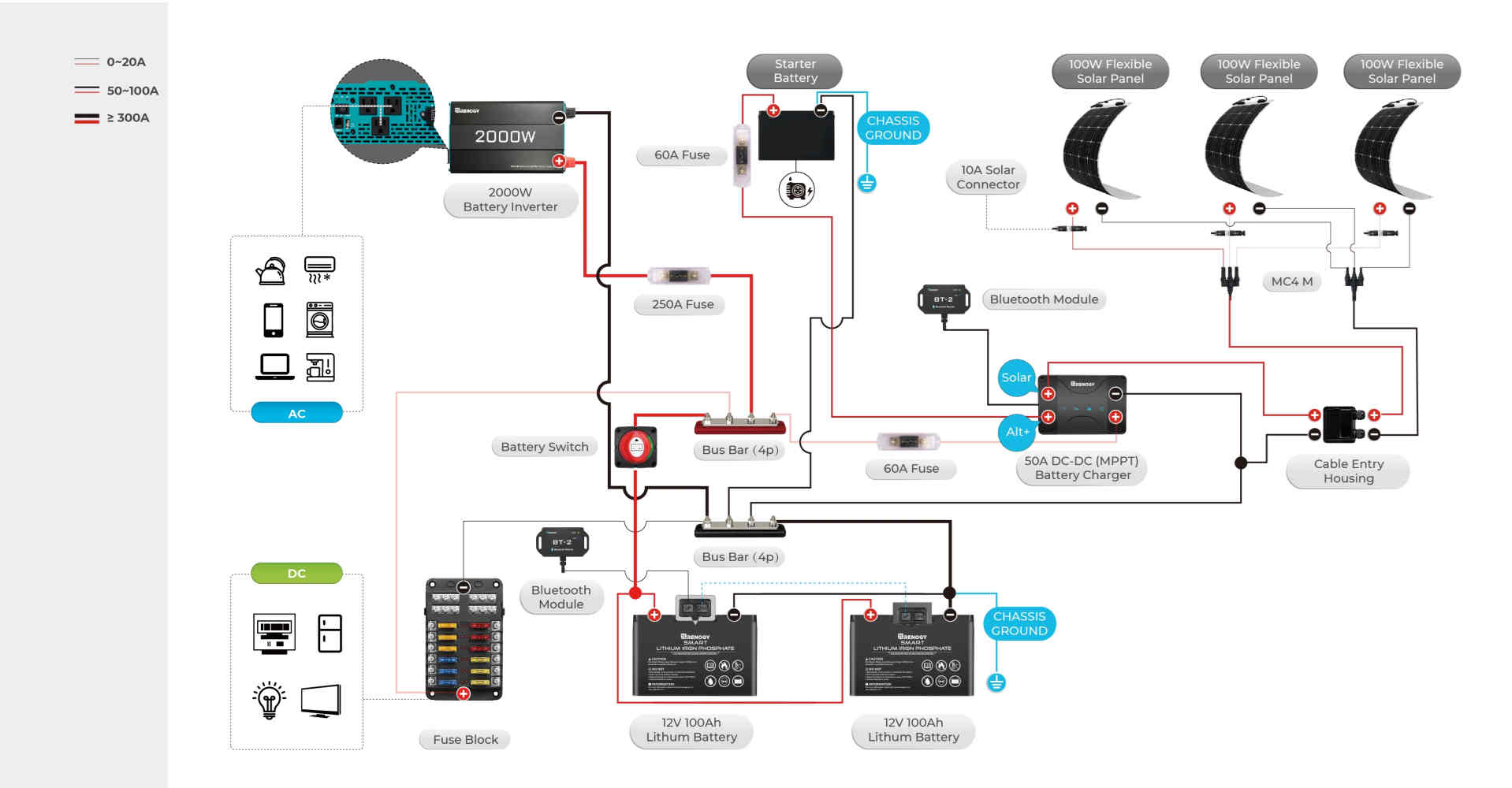
Do I need an inverter for my RV?
An RV inverter is increasingly becoming a necessity for those who want to enjoy staying in an RV.
You need an inverter for your RV if any of the following points describe your situation:
●If you want to be able to use your TV and other AC devices while you are off-grid.
●If you want to turn your mobile abode into a comfortable home with all the luxuries and necessities that modern technology provides.
●If you want a cleaner, cheaper and quieter alternative to generators.
On the other hand, if you think you can survive without the convenience of most home appliances then you might be able to do without an inverter. But the keyword is 'survive'.
Without an inverter, your RV will not have many features that are commonplace in most homes. So you need at least a small RV inverter you can use to charge your phone, camera, or laptop.
Some RVs are now coming preinstalled with an inverter.
But how do you know if your RV has a pre-installed inverter or not?
If your 120V AC outlets only work while the generator is running but stop working as soon the generator stops, you don’t have an inverter in your RV.
How much does an inverter for an RV cost?
You can find RV inverters with a price tag anywhere from $100 to over $2000.
As you can see, there's a wide price range that is influenced by four factors:
1.Size of the inverter
2.Features of the inverter (LCD screen, remote control and monitoring, etc.)
3.Brand of the inverter
4.Performance (Durability, Reliability, and Efficiency)
Renogy’s inverters price range from as little as $124 to just under $800. Our range of products is designed to give you the maximum value for your money.
Can an inverter power a whole RV?
With an inverter of the right size, you can power your whole RV without any problem. But the point is an inverter of the right size. If you pick a small inverter and can't produce sufficient power to meet your needs, you are going to have problems.
If you pick an inverter that’s too big, it’s going to waste a lot of power. So it’s vital to ensure you get an inverter of the right size that can provide wattage that can satisfy your demand for your AC devices.
The secret to powering your whole RV using a single inverter is to use an inverter whose capacity is slightly above your actual demand. Ideally, your inverter's capacity should be at least 20% more than your demand.
Can more than one inverter be used at the same time?
Yes! You can use more than one inverter at the same time. But the story doesn’t end there. If you want to effectively use multiple inverters here is what you need to know.
You can use multiple inverters in parallel to produce a higher power capacity. More power produced equals more devices that can be supported. The only drawback to running more inverters is that your batteries drain faster.
An analogy you can use here is to imagine you have a tank of gas that can get one car from point A to B. If this tank of gas is shared between two cars instead, they will only be able to go half as far but they will be able to carry twice as much stuff.
In the same manner, using two or more inverters will drain your batteries faster but in return, you can power up more devices.
What is the difference between an RV inverter and an RV converter?
An inverter and a converter are opposites of each other.
How? While an RV inverter converts Direct Current (DC) into Alternating Current (AC), an RV converter converts Alternating Current (AC) into Direct Current (DC).

Here are other differences between an RV inverter and a converter:
●The RV inverter converts electricity for use by AC devices while the converter converts AC power to DC to be used by the RV's DC devices.
●The inverter's main source of power is batteries whereas the main source of power for a converter is shore power from the main power grid.
●You can use an RV converter to charge your batteries while an RV inverter can only take energy from your battery.
Pure Sine Wave vs. Modified Sine Wave
If you are ready to buy an RV inverter, you need to know the difference between Pure Sine Wave and Modified Sine Wave inverters.
It would be a shame to buy a Modified Sine Wave inverter when what you need is a Pure Sine Wave inverter.
So what’s the difference between Pure Sine Wave and Modified Sine Wave?
The wave generated by the output of a Pure Sine Wave inverter is almost identical to the actual sine wave generated by your electric power company. As a result, your AC devices will be able to seamlessly switch from working with the power utility’s supply to the inverter’s supply without affecting device performance.
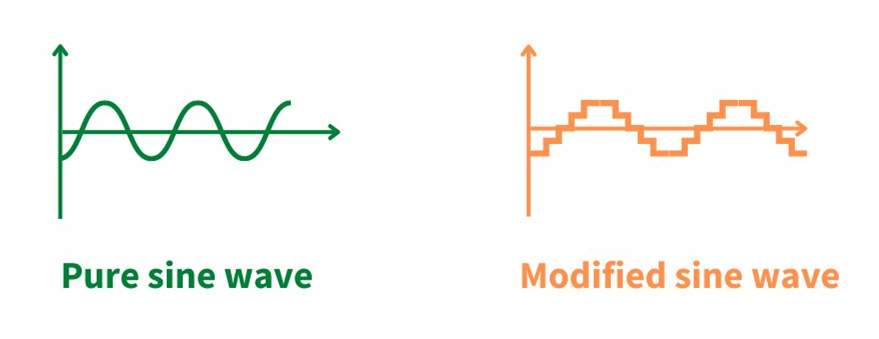
In contrast, the wave generated by a Modified Sine Wave inverter is different from the actual sine wave from your power utility. Instead of having gradual curves that alternate between positive and negative, a modified sine wave looks like a set of stairs traveling between positive and negative.
As a result, some delicate or sensitive electronics will be adversely affected by the staggered sine wave. So they won’t perform well, may suffer damage, or in some cases will produce an audible humming sound due to the modified sine wave.
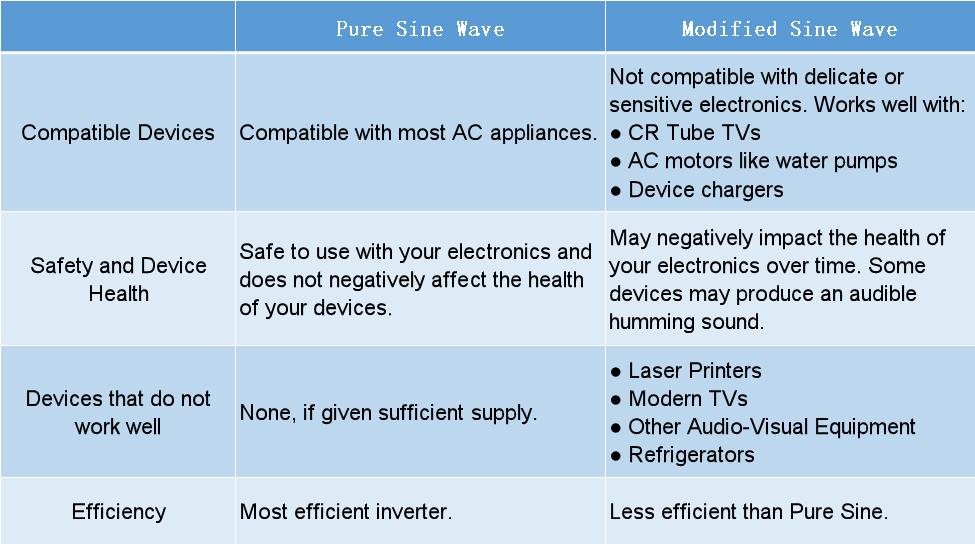
If you plan to use delicate electronics like a TV or radio in your RV or camper, we recommend you get a pure sine wave inverter.
On the other hand, if you don't use any of the devices mentioned above, you can probably use a modified sine wave inverter with most devices including:
●Tube TVs
●Water Pumps
●Device Chargers
Is an RV inverter worth it?
For many people, buying an inverter is worth it because it offers many benefits like:
●It enables you to use free energy from the sun.
●It’s a cheaper source of energy in the long run.
●They are quieter than generators and don’t pollute the environment.
●It’s a portable source of power that you can use anywhere.
●They are small and can easily fit inside a camper or RV.
The above benefits are only the tip of the iceberg. Once you start using an inverter you will find something new to love every day.
So is an RV inverter worth it?
Many would say yes. Buying an RV inverter is definitely worth it if you want to live your best life in an RV.
Best Power Inverter For an RV
Renogy store has covered the best line of solar inverters for RVs, all using state-of-art technologies such as the power-saving mode and Bluetooth connectivity and coming with durable quality. The 3000w inverter (inverter only) is an excellent choice if all you need is something to power your AC devices. On the other hand, getting a 2000W or 3000W inverter charger (inverter + converter) may be ideal if you want to charge batteries using shore power or power DC gadgets using the AC supply,

